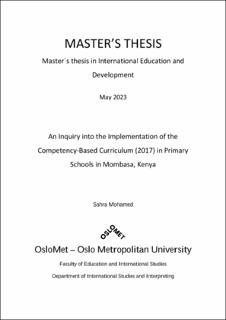| dc.description.abstract | According to Fein (2015), as cited in (Isaboke, Wambiri, & Mweru, 2021, p. 72), the competency-based medium of instruction was first implemented in teacher education in America in the1970s. Many countries developed it after that and implemented it in their education systems (Sanchez & Romero, 2015). UNESCO defines a Competency-Based Curriculum as ´an education system that puts emphasis on the many-sided results of a learning process. Other education systems focus on what learners are expected to learn, the banking model of teaching (Anderson, 2022). Kenya is now in the seventh year of implementing the competency-based curriculum. The researcher conducted a study in Mombasa town. The present study contributes to our understanding of the Competency-Based curriculum in Kenya through a comparison of two private schools with two public schools. Qualitative data was gathered using interviews, observation, and document analysis. Teachers and headteachers were interviewed to find out how they understood and implemented the curriculum. During the study, grades 4 and 6 were observed. In the document analysis, the researcher looked at teachers’ professional records and analysed the Kenya Gazette Special Issue on The Presidential Working Party on Education Reform (Gazette Notice No: 11920). John Goodlad´s work on curriculum was used as the theoretical framework. Goodlad's work in 1979 contributed to the development of a comprehensive framework for understanding the curriculum field. Notably, he established a strong correlation between curriculum practice and research, as highlighted by Shen (1999, p. 41). Drawing upon this significant connection, the present study is firmly grounded in a strong theoretical lens. Goodlad's insights emphasise that curriculum implementation is influenced by multiple domains, which are the ideological, formal, perceived, operational, and experienced curriculum (Goodlad, 1979, p. 58). This thesis will focus on three main domains: formal, perceived, and operational domains. The study found that although the process of the Competency-Based Curriculum implementation at the primary level is complete, it is facing considerable amounts of challenges that need to be urgently addressed. Secondly, interview data from teachers who took part in the study reveal that most of the teachers in the primary school received some form of training through government-sponsored workshops and seminars. It was however reported that the training that was conducted was inadequate. Thirdly, it was reported that the implementation of CBC required the use of intensive resources supplied either by schools or parents. Concerns were therefore raised on how equity was assured considering schools are not endowed with equal resources. | en_US |
